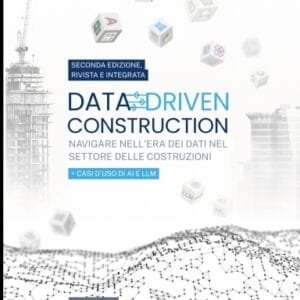DATA-DRIVEN CONSTRUCTION. Navigating the data age in the construction industry
FOR WHOM THIS BOOK IS FOR
Written in accessible language, this book is aimed at a wide range of readers in the construction industry, from students and novices who want to grasp the basics of modern construction processes to professionals who need an up-to-date methodology for managing data in construction. Whether you are an architect, engineer, foreman, construction manager, or data analyst, this comprehensive guide with many unique illustrations and charts offers valuable insights on how to use data in business to optimize and automate processes, improve decision-making, and manage construction projects at different levels using modern tools
The book is a comprehensive guide that combines theoretical foundations and practical recommendations for integrating data management techniques into construction processes. The book focuses on the strategic use of information to optimize operations, automate processes, improve decision-making and effectively manage projects using modern digital tools.
This book covers theoretical and practical aspects of working with information in the construction industry. Through detailed examples, it explores the methodology of task parameterization, requirements gathering, processing unstructured and multiformat data and transforming it into effective solutions for construction companies.
The reader successively passes the way from the formation of requirements and development of basic data models to more complex processes of integration of heterogeneous sources of information, creation of ETL -processes, construction of information Pipeline and machine learning models. The sequential approach allows you to clearly demonstrate the mechanisms of organization and automation of business processes and decision support systems in the construction industry. Each part of the book concludes with a practical chapter containing step-by-step instructions that enable immediate application of the acquired knowledge in real projects.
SUMMARIZED DESCRIPTION OF PARTS OF THE BOOK
This book is organized around the concept of transforming data in the value chain: from data collection and quality assurance to analytical processing and extracting valuable practical solutions using modern tools and methodologies.
Beginning of the form
Part 1: Digital Evolution in Construction – Traces the historical transformation of data management from clay tablets to modern digital systems, analyzing the emergence of modular systems and the growing importance of information digitalization in the context of industrial revolutions.
Part 2: Information Challenges for the Construction Industry – explores the problems of data fragmentation, ‘information silos’, the impact of the HiPPO approach on decision making and the limitations of proprietary formats, suggesting consideration of the move to AI and LLM ecosystems.
Part 3: Data Systematization in Construction – forms a typology of construction data, describes methods of its organization, integration with corporate systems and discusses the creation of competence centers for standardization of information processes.
Part 4: Data Quality Assurance – reveals methodologies for turning disparate information into quality, structured data, including data extraction from various sources, validation, and modeling using LLM.
Part 5: Cost and Time Calculations – covers digitalization of cost and scheduling calculations, automation of obtaining volumes from CAD (BIM) models, 4D-8D modeling technologies, and ESG calculations for construction projects.
Part 6: CAD and BIM – Critically analyzes the evolution of design technologies, system interoperability issues, trends toward open data formats, and the prospects for applying artificial intelligence to design.
Part 7: Data Analytics and Automation – examines the principles of information visualization, key performance indicators, ETL processes, workflow orchestration tools, and the application of language models to automate routine tasks.
Part 8: Data Storage and Management – explores data storage formats, data warehouse and data lake concepts, data management principles, and new approaches including vector databases and the DataOps and VectorOps methodologies.
Part 9: Big Data and Machine Learning – focuses on the transition to objective analysis based on historical data, the Internet of Things on construction sites, and the application of machine learning algorithms to predict project costs and timelines.
Part 10: The Construction Industry in the Age of Digital Data – presents a look at the future of the construction industry, analyzing the shift from causal analysis to working with correlations, the concept of “Uberizing” construction, and strategies for digital transformation.
Additional information
UNLOCK THE POWER OF DATA
IN CONSTRUCTION
Dive into the world of data-driven construction with this accessible guide, perfect for professionals and novices alike.
From the basics of data management to cutting-edge trends in digital transformation, this book
will be your comprehensive guide to using data in the construction industry.





































